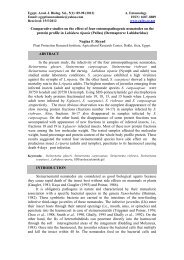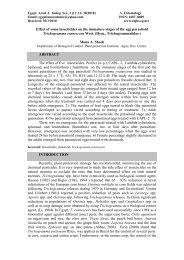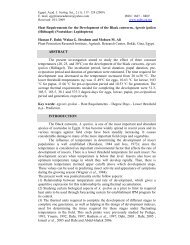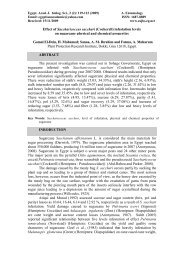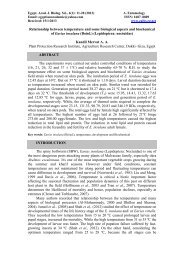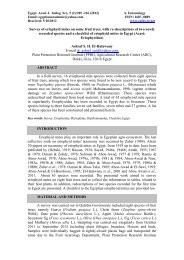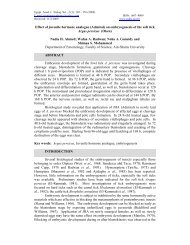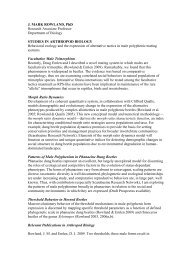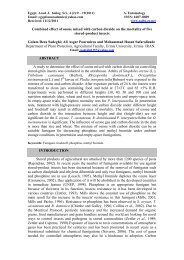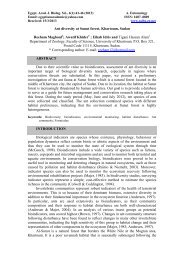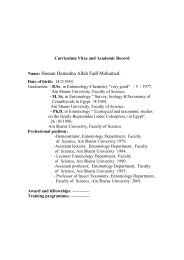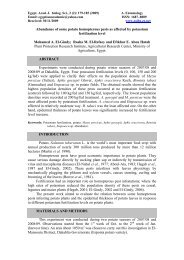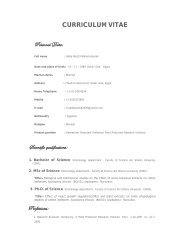Scale insects (Hemiptera: Coccoidea) - egyptian academic journal ...
Scale insects (Hemiptera: Coccoidea) - egyptian academic journal ...
Scale insects (Hemiptera: Coccoidea) - egyptian academic journal ...
You also want an ePaper? Increase the reach of your titles
YUMPU automatically turns print PDFs into web optimized ePapers that Google loves.
<strong>Scale</strong> <strong>insects</strong> (<strong>Hemiptera</strong>: <strong>Coccoidea</strong>) infesting apple, apricot 27<br />
While Table (3) showed that pear trees infested by 10 scale insect species: 8<br />
species belonging to Family Diaspididae and one species of Families Coccidae and<br />
Pseudococcidae. Also during the present work 8 parasitoid species recorded<br />
associated with aforementioned scale <strong>insects</strong>.<br />
Table 3: List of scale <strong>insects</strong> infesting pear trees and their abundant parasitoids in Egypt<br />
Species Family Abundant Parasitoids Date<br />
1. Aonidiella aurantii (Maskell) Diaspididae Encarsia citrina (Craw) July,2009<br />
2. Hemiberlesia rapax (Comstock) Diaspididae Pteroptrix aegyptica Evans &<br />
Abd-Rabou<br />
June, 2010<br />
3. Lepidosaphes beckii (Newman) Diaspididae Aphytis lingnanensis Comepre September,2010<br />
4. Lepidosaphes gloverii (Packard) Diaspididae Encarsia citrina (Craw) June, 2010<br />
5. Melanaspis inopinata (Leonardi) Diaspididae Aphytis chrysomphali (Mercet) October,<br />
2011<br />
6. Mycetaspis personata (Comstock) Diaspididae Aphytis sinaii Abd-Rabou October, 2010<br />
7. Parasaissetia nigra (Nietner) Coccidae Microterys flavus (Howard) July,2010<br />
8. Parlatoreopsis longispina Diaspididae Aphytis chrysomphali (Mercet) September, 2011<br />
(Newstead)<br />
9. Parlatoria oleae (Colvee) Diaspididae Aphytis diaspidis (Howard) November, 2010<br />
10. Planococcus citri (Risso) Pseudococcidae Leptomastidea<br />
(Girault)<br />
abnormis September, 2009<br />
Eleven armored scale insect species attacking 62 host plant species including<br />
apple, apricot and pear (Hammad and Moussa, 1973). The host of P. oleae was apple<br />
(El-Minshawy et al., 1974). R. pustulans attacked apple trees in Egypt (Mangoud,<br />
1994).<br />
Abd-Rabou (1997b) recorded that the parasitoid, Aphytis chrysomphali (Mercet)<br />
associated with five armored scale <strong>insects</strong> in different locations in Egypt. Aphytis<br />
diaspidis (Howard) was recorded for the first time in Egypt by Priesner & Hosny<br />
(1940).<br />
Hafez (1988) recorded Aphytis lingnanensis Comepre as the most common<br />
species of A. aurantii on Citrus sp. Priesner & Hosny (1940) recorded Aphytis<br />
mytilaspidis (Le Baron) for the first time in Egypt from all over the Nile Delta.<br />
Aphytis sinaii Abd-Rabou was collected in a few numbers by Abd-Rabou (2004).<br />
Encarsia citrina (Craw) was recorded for the first time in Egypt by Priesner & Hosny<br />
(1940). Abd-Rabou (1997a) mentioned that E. citrina should be considered a<br />
promising candidate for utilization in biological control of armored scale <strong>insects</strong> in<br />
Egypt. This species was reared from 8 species of diaspidid scale <strong>insects</strong> and<br />
maximum parasitism rates ranged between 23 and 65%. Pteroptrix aegyptica (Evans<br />
& Abd-Rabou) was recorded for the first time in Egypt by Evans and Abd-Rabou<br />
(2005). Habrolepis aspidioti (Compere & Annecke) was recorded for the first time in<br />
Egypt by Priesner and Hosny (1940). This species reported as an effective parasitoid<br />
on different armored scale <strong>insects</strong> in different locations in Egypt (Abd-Rabou,1997c).<br />
Blepyrus insularis (Cameron) was recorded for the first time in Egypt by Awadallah<br />
et al.(1999). Leptomastidea abnormis (Girault) was recorded for the first time in<br />
Egypt by Abd-Rabou and its reared from M. hirsutus with maximum parasitism rate<br />
was 21% (Abd- Rabou, 2000). Leptomastix dactylopii Howard was recorded for the<br />
first time in Egypt and its was reared from M. hirsutus with maximum parasitism rate<br />
was 8% (Abd- Rabou, 2000). Coccophagus scutellaris (Dalman) collected for the first<br />
time in Egypt by Priesner and Hosny (1940). Metaphycus lounsburyi (Howard) was<br />
recorded for the first time in Egypt by Abd-Rabou(1998). Microterys flavus (Howard)<br />
was recorded for the first time in Egypt and the rate of parasitism of this species on C.<br />
floridensis, averaged 0.8 and 2.4% during the two years under considerations,



